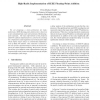Free Online Productivity Tools
i2Speak
i2Symbol
i2OCR
iTex2Img
iWeb2Print
iWeb2Shot
i2Type
iPdf2Split
iPdf2Merge
i2Bopomofo
i2Arabic
i2Style
i2Image
i2PDF
iLatex2Rtf
Sci2ools
ARITH
2005
IEEE
2005
IEEE
High-Radix Implementation of IEEE Floating-Point Addition
We are proposing a micro-architecture for highperformance IEEE floating-point addition that is based on a (non-redundant)high-radix representation of the floatingpoint operands. The main improvement of the proposed IEEE FP addition implementation is achieved by avoiding the computation of full alignment and normalization shifts which impose major delays in conventional implementations of IEEE FP addition. This reduction is achieved at the cost of wider operand interfaces and an increased complexity for IEEE compliant rounding. We present a detailed discussion of an IEEE FP adder implementation using the proposed high-radix format and explain the specific benefits and challenges of the design.
Related Content
| Added | 24 Jun 2010 |
| Updated | 24 Jun 2010 |
| Type | Conference |
| Year | 2005 |
| Where | ARITH |
| Authors | Peter-Michael Seidel |
Comments (0)

